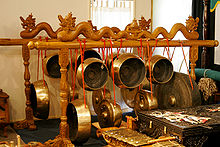Gamelan angklung

Angklung with eight pitches
|
|
| Percussion instrument | |
|---|---|
| Classification | Idiophone |
| Hornbostel–Sachs classification | 111.232 (Sets of percussion tubes) |
| Developed | Indonesia |
| Music of Indonesia | |
|---|---|

Kempul gongs from Java
|
|
| Genres | |
| Specific forms | |
| Regional music | |
The angklung is a musical instrument from Indonesia made of a varying number of bamboo tubes attached to a bamboo frame. The tubes are carved to have a resonant pitch when struck and are tuned to octaves, similar to American handbells. The base of the frame is held in one hand, whilst the other hand shakes the instrument. This causes a repeating note to sound. Each of three or more performers in an angklung ensemble play just one note or more, but altogether complete melodies are produced.
The angklung is popular throughout Southeast Asia, but it originated in what is now West Java and Banten provinces in Indonesia, and has been played by the Sundanese for many centuries. Angklung and its music has become the cultural identity of Sundanese communities in West Java and Banten. Playing the angklung as an orchestra requires cooperation and coordination, and is believed to promote the values of teamwork, mutual respect and social harmony.
On November 18, 2010, UNESCO officially recognized the Indonesian angklung as a Masterpiece of Oral and Intangible Heritage of Humanity, and encouraged the Indonesian people and the Indonesian government to safeguard, transmit, promote performances and to encourage the craftsmanship of angklung.
The word "angklung" may have originated from Sundanese "angkleung-angkleungan", suggesting the movement of the angklung player and the "klung" sound that comes from the instrument.
Another theory suggests that the word "angklung" was formed from two Balinese words – angka and lung. Angka means "tone", and lung means "broken" or "lost". Angklung thus means "incomplete tone".
According to Dr. Groneman, angklung had already been a favorite musical instrument of the entire archipelago even before the Hindu era. According to Jaap Kunst in Music in Java, besides West Java, angklung also exists in South Sumatra and Kalimantan. Lampung, East Java and Central Java are also familiar with the instrument.
...
Wikipedia
